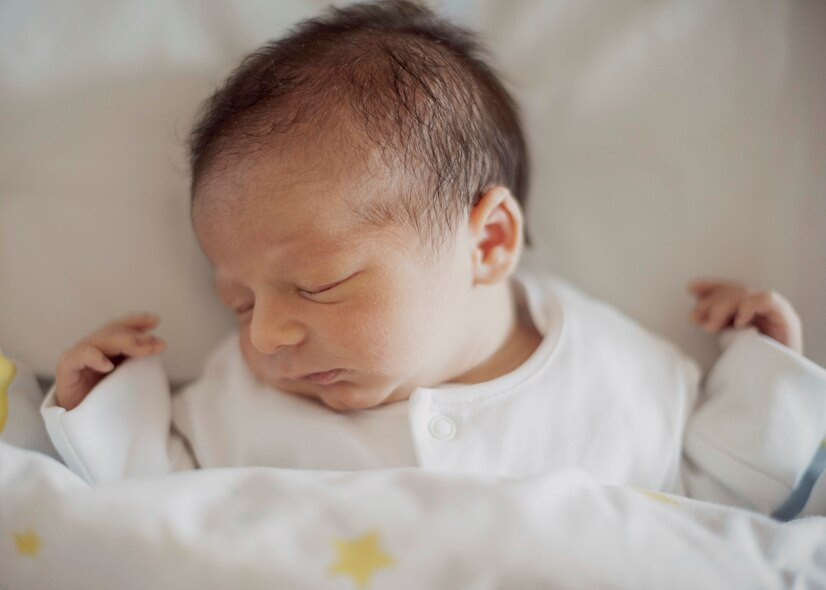Jika diamati, Anda akan melihat adanya rambut halus yang melapisi tubuh bayi ketika mereka dilahirkan. Rambut halus ini tumbuh di kulit bayi ketika masih berada dalam kandungan. Bukan hanya sekadar rambut biasa, rambut halus ini memiliki banyak peran penting bagi bayi. Apa sajakah itu?
Apa itu Lanugo
Rambut halus yang melapisi tubuh bayi disebut dengan lanugo. Rambut-rambut ini mulai tumbuh di trimester kedua kehamilan dan mencapai puncaknya sekitar minggu ke-20 kehamilan.
Beberapa bayi mungkin kehilangan rambut-rambut halus ini sebelum lahir, namun beberapa bayi lainnya masih memiliki lanugo yang menutupi sebagian atau seluruh tubuh saat lahir. Lanugo tidak akan menutupi tubuh bayi selamanya. Dalam beberapa minggu, rambut-rambut halus ini akan rontok.
Baca Juga: Tahi Lalat pada Bayi, Ini yang Perlu Diwaspadai
Fungsi dan Manfaat Lanugo
Walau terlihat sebagai rambut halus yang biasa saja, lanugo memiliki banyak fungsi penting bagi bayi dan perkembangannya, di antaranya:
Sebagai perlindungan kulit
Bersamaan dengan vernix caseosa, lanugo menempel pada kulit janin dan menutupi kulit janin. Vernix caseosa sendiri merupakan lapisan zat lilin yang menutupi kulit janin, dan melindungi kulit dari cairan ketuban yang dapat mengiritasi dan mengganggu kulit yang masih sensitif.
Vernix caseosa dan lanugo bekerja bersama-sama membentuk barier kulit yang efektif untuk mencegah cairan ketuban merusak kulit yang masih halus dan rentan. Ini merupakan mekanisme pertahanan untuk melindungi tubuh janin selama masa perkembangan, khususnya di dalam rahim.
Menjaga suhu tubuh
Lanugo membantu menjaga suhu tubuh janin di dalam rahim tetap stabil. Ini sangat penting karena janin belum memiliki kemampuan mengatur suhu tubuhnya sendiri seperti orang dewasa.
Regulasi hormon
Sebuah teori menyatakan bahwa lanugo juga berperan dalam pelepasan hormon dalam mengurangi stres dan merangsang pertumbuhan di dalam rahim. Meski belum sepenuhnya dipahami, penelitian menunjukkan bahwa sentuhan lembut pada kulit bayi dapat merangsang pelepasan hormon-hormon yang mengurangi stres seperti oksitosin dan endorfin.
Baca Juga: Mengapa Bayi Baru Lahir Sering Bersin?
Kapan Bayi Kehilangan Lanugo?
Sebagian besar bayi akan kehilangan lanugo sesaat sebelum lahir. Sebagian lainnya masih memiliki lanugo saat dilahirkan. Sedangkan bayi lahir prematur cenderung memiliki lanugo lebih banyak dan membutuhkan waktu beberapa minggu untuk kehilangan rambut-rambut ini.
Pada tahap akhir kehamilan, umumnya lanugo akan mulai hilang, terlepas dari kulit bersamaan dengan cairan ketuban. Karena bayi menelan cairan ketuban di dalam rahim, lanugo menjadi bagian dari makanan pertama bayi yang secara alami membantu mempersiapkan diri untuk kehidupan di luar rahim.
Ketika lanugo rontok, bayi akan mengembangkan rambut Vellus, yaitu rambut halus seperi bulu yang membantu dalam mengatur suhu tubuh bayi hingga rambut dewasa tumbuh.
Perlukah Menghilangkan Lanugo?
Lanugo bukanlah sesuatu yang berbahaya bagi bayi sehingga tidak perlu berusaha menghilangkannya. Anda perlu bersabar dan membiarkan lanugo rontok dengan sendirinya tanpa menggunakan pencukur rambut maupun waxing.
Pijatan lembut pada kulit bayi menggunakan baby oil dapat membantu mempercepat proses kerontokan lanugo. Namun, Anda perlu berhati-hati dalam memilih produk baby oil agar tidak menyebabkan iritasi pada kulit bayi.
Apabila Anda memiliki pertanyaan atau kekhawatiran tersendiri terkait dengan rambut-rambut halus pada bayi, Anda bisa berkonsultasi dengan dokter melalui aplikasi Ai Care yang bisa diunduh di App Store atau Play Store.
Mau tahu informasi seputar kehamilan, menyusui, kesehatan wanita dan anak-anak? Cek di sini, ya!
- dr. Monica Salim
Cleveland Clinic (2022). Lanugo. Available from: https://my.clevelandclinic.org/health/body/22487-lanugo
Donna Murray, RN, BSN (2021). What Is Lanugo?. Available from: https://www.verywellfamily.com/what-is-lanugo-and-is-it-a-concern-in-newborns-4177351
WebMD (2023). Why Are Some Babies Born With a Lot of Hair?. Available from: https://www.webmd.com/baby/why-are-some-babies-born-with-a-lot-of-hair
Ashley Braun, MPH, RD (2024). What Is Vernix Caseosa?. Available from: https://www.verywellhealth.com/vernix-caseosa-5185577
Brendon L. Verhave, et all (2022). Embryology, Lanugo. Available from: https://www.ncbi.nlm.nih.gov/books/NBK526092
Cleveland Clinic (2022). Vellus Hair (Peach Fuzz). Available from: https://my.clevelandclinic.org/health/body/23098-vellus-hair-peach-fuzz











